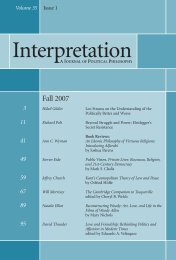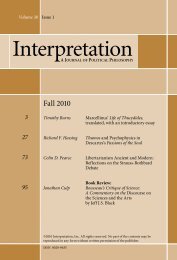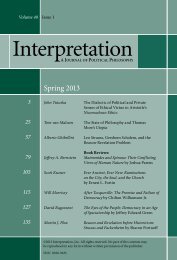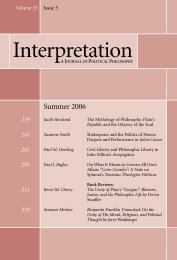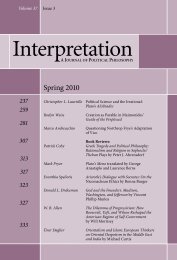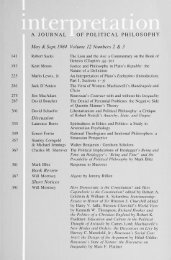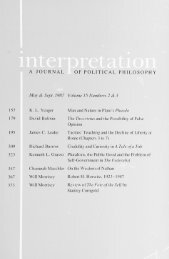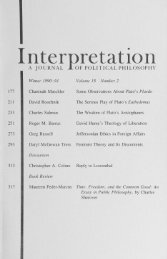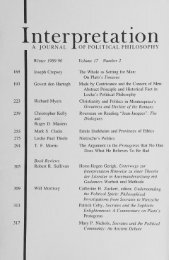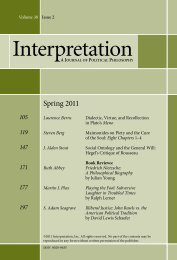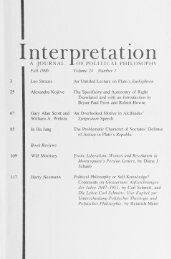Interpretation: A Journal of Political Philosophy
Interpretation: A Journal of Political Philosophy
Interpretation: A Journal of Political Philosophy
Create successful ePaper yourself
Turn your PDF publications into a flip-book with our unique Google optimized e-Paper software.
168<br />
"Limit"<br />
<strong>Interpretation</strong><br />
in the Philebus can also be named the "One."<br />
calls the "elements"<br />
What Aristotle<br />
can be called the ultimate sources <strong>of</strong> everything, that<br />
which has the first rank both as beginnings and as ruling<br />
powers. That is<br />
what is meant by dpxr), in common parlance as well as in most thoughtful<br />
speech. We should not assume, I think, that Plato had a definitely fixed<br />
name for each <strong>of</strong> these dpxat. The terms the Good, the One, the Precise<br />
itself, the Same, the Limit, and perhaps the Whole are aU suited to one<br />
<strong>of</strong> the dpxai, depending on the context in which they<br />
names <strong>of</strong> the second ao/i], the "indeterminate dyad,"<br />
as the less,"<br />
are used. As to the<br />
"the more as well<br />
and the Other (which also implies a duality 38) seem aU <strong>of</strong> them<br />
no less suitable. In the Philebus Socrates, in putting a seal on the tribe <strong>of</strong><br />
the cbiEipov, makes its intrinsic character perfectly clear. But the character<br />
<strong>of</strong> the jtspag, the "limit,"<br />
remains obscured.<br />
Now let us take up the third tribe,<br />
<strong>of</strong> the "Limit."<br />
dpxai, the "Limitless,"<br />
"One,"<br />
What does "mixing"<br />
"mixture"<br />
the <strong>of</strong> the "Limitless"<br />
the "indeterminate dyad,"<br />
and<br />
here mean? It means that the two<br />
and the "Limit,"<br />
exert their power on each other. What happens then may be<br />
described as follows. The "indeterminate dyad"<br />
duplicates the "One,"<br />
is to say, produces two entities, two i8r|, duplicates each <strong>of</strong> these<br />
ei8t| we may also say "divides"<br />
the<br />
that<br />
each <strong>of</strong> these i8r| and keeps on du<br />
plicating we have to assume up to a certain point. In Aristotle's reports<br />
the "indeterminate dyad"<br />
is explicitiy characterized as a "doubling<br />
power"<br />
(8uojtoiog). 39 It is the ultimate source <strong>of</strong> definite manyness, <strong>of</strong><br />
"numbers,"<br />
in the realm <strong>of</strong> the Ei8n as weU as in our world. In the earlier<br />
passage, when Socrates first introduced the Promethean gift <strong>of</strong> "infinitude"<br />
and <strong>of</strong> "limit"<br />
and urged that in every case a definite number <strong>of</strong> tibr\ had<br />
to be found (the alphabet helping him to clarify this point), there was<br />
hardly<br />
a discernible hint that the "Limitless"<br />
with its doubling power is<br />
responsible for the multiplicity <strong>of</strong> the ei8i> You wiU remember that in<br />
this context the "limitless,"<br />
the infinite, was ultimately dismissed. Not so<br />
in the world in which we live. What happens here is this: the "Limit,"<br />
the "One,"<br />
transforms the "indeterminate dyad"<br />
into a determinate one,<br />
that is to say, transforms the two constantly and indeterminately changing<br />
terms <strong>of</strong> the dyad into two stationary and determinate ones and keeps<br />
doing this, produces, in other words, a multitude <strong>of</strong> ratios. That's why<br />
Socrates can call the manyness <strong>of</strong> ratios "the <strong>of</strong>fspring <strong>of</strong> the limit." 40<br />
We understand now what confused Protarchus and us when Socrates<br />
substituted "that which has limit,"<br />
The "limited,"<br />
the "limited,"<br />
for the "limit"<br />
itself.<br />
the assemblage <strong>of</strong> ratios, is already a part <strong>of</strong> the mixture,<br />
<strong>of</strong> the third tribe. But it represents a mixture, or rather mixtures,<br />
<strong>of</strong> a<br />
special kind, mathematical partnerships that can give to parts <strong>of</strong> the<br />
world we live in a certain Tightness, remove the excess and indefiniteness,<br />
ss Cf. Soph. 255 D and 256 E-257 A.<br />
so Met. XIII, 7, 1082 a 15 and 8, 1083 b 36.<br />
25 D.



